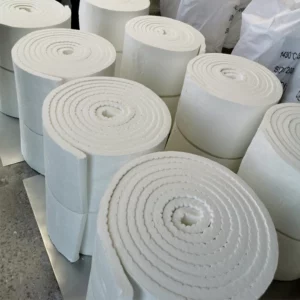When working with ceramic fiber insulation, it is important to follow safety guidelines to minimize potential risks and ensure a safe working environment.
Here are some general safety guidelines to consider:
Personal Protective Equipment (PPE): Wear appropriate PPE as recommended by the manufacturer or supplier. This may include safety glasses or goggles, gloves, long-sleeved clothing, and respiratory protection, such as a dust mask or respirator, depending on the specific application and exposure levels.
Handling and Installation: Handle ceramic fiber insulation with care to avoid unnecessary fiber release. Avoid tearing or damaging the material during installation. Follow the manufacturer’s instructions for cutting, shaping, and securing the insulation.
Respiratory Protection: In situations where there is a potential for airborne fiber release, use respiratory protection. Select respiratory equipment that is suitable for the specific fiber type and concentration. Follow proper fitting and maintenance procedures for the respirator.
Ventilation: Ensure adequate ventilation in the work area to minimize the accumulation of airborne dust or fibers. Use local exhaust ventilation or general ventilation to maintain clean air and reduce exposure.
Minimize Dust Generation: Take measures to minimize the generation of dust or fibers during handling or cutting of ceramic fiber insulation. Use wet methods, such as misting or wetting the material, to control dust and fiber release. Avoid using compressed air or dry sweeping methods that can disperse fibers into the air.
Hygiene Practices: Practice good personal hygiene to minimize the risk of fiber ingestion or inhalation. Wash hands and face thoroughly after handling ceramic fiber insulation. Avoid eating, drinking, or smoking in the work area to prevent accidental ingestion of fibers.
Storage and Disposal: Store ceramic fiber insulation in a dry and secure area to prevent moisture absorption and damage. Follow local regulations and guidelines for the proper disposal of waste materials. Dispose of any waste or scraps in accordance with applicable laws and regulations.
Training and Education: Provide appropriate training and education to workers who handle or work with ceramic fiber insulation. ceramic fiber insulation blanket roll Ensure they are aware of the potential hazards, safe handling practices, and emergency procedures.
It is important to note that these guidelines provide general safety considerations. Always refer to the specific safety recommendations and guidelines provided by the manufacturer or supplier of the ceramic fiber insulation, as they may have additional or more specific instructions based on their product’s characteristics and application.
What are some common methods for cutting and shaping ceramic fiber insulation?
There are several common methods for cutting and shaping ceramic fiber insulation. The specific method used may depend on the thickness and density of the insulation, as well as the desired shape or size.
Here are some commonly used methods:
Scissors or Shears: For thinner and less dense ceramic fiber insulation, scissors or shears can be used to cut the material. Choose sturdy scissors or shears with sharp blades to ensure clean and precise cuts.
Utility Knife: A utility knife with a sharp blade can be used to score the surface of the ceramic fiber insulation. Once scored, the material can be easily broken or snapped along the scored line. Take caution to avoid applying excessive force that may cause the material to crumble or release fibers.
Saw: For thicker and denser ceramic fiber insulation, a saw with a diamond or carbide-tipped blade can be used. This method is suitable for cutting through the material with greater precision and ease. Ensure the saw is equipped with proper safety guards and follow safe operating practices.
CNC Cutting: Computer Numerical Control (CNC) cutting machines can be used for precise and automated cutting of ceramic fiber insulation. This method is ideal for complex shapes or large-scale production where consistent and accurate cuts are required.
Water Jet Cutting: Water jet cutting utilizes a high-pressure stream of water mixed with abrasive particles to cut through ceramic fiber insulation. This method is effective for achieving precise cuts without generating excessive heat.
When working with ceramic fiber insulation, it is important to follow safety guidelines and wear appropriate personal protective equipment (PPE). Minimize dust generation by using wet cutting methods or dust collection systems where applicable. Follow the manufacturer’s recommendations and guidelines for cutting and shaping specific types of ceramic fiber insulation.
It’s worth noting that the suitability of each cutting method may vary depending on the specific characteristics of the ceramic fiber insulation, such as thickness, density, and composition. Always refer to the manufacturer’s instructions or consult with a professional to determine the most appropriate method for your particular application.

Comments